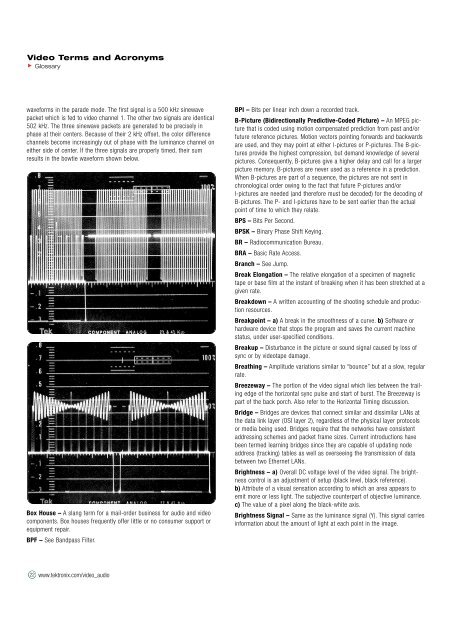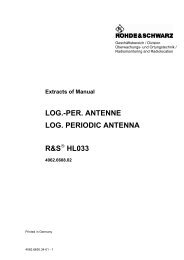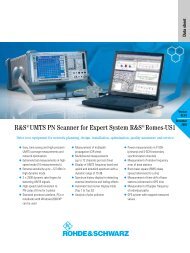Glossary of Video Terms and Acronyms - Isotest
Glossary of Video Terms and Acronyms - Isotest
Glossary of Video Terms and Acronyms - Isotest
Create successful ePaper yourself
Turn your PDF publications into a flip-book with our unique Google optimized e-Paper software.
<strong>Video</strong> <strong>Terms</strong> <strong>and</strong> <strong>Acronyms</strong><br />
<strong>Glossary</strong><br />
waveforms in the parade mode. The first signal is a 500 kHz sinewave<br />
packet which is fed to video channel 1. The other two signals are identical<br />
502 kHz. The three sinewave packets are generated to be precisely in<br />
phase at their centers. Because <strong>of</strong> their 2 kHz <strong>of</strong>fset, the color difference<br />
channels become increasingly out <strong>of</strong> phase with the luminance channel on<br />
either side <strong>of</strong> center. If the three signals are properly timed, their sum<br />
results in the bowtie waveform shown below.<br />
Box House – A slang term for a mail-order business for audio <strong>and</strong> video<br />
components. Box houses frequently <strong>of</strong>fer little or no consumer support or<br />
equipment repair.<br />
BPF – See B<strong>and</strong>pass Filter.<br />
22 www.tektronix.com/video_audio<br />
BPI – Bits per linear inch down a recorded track.<br />
B-Picture (Bidirectionally Predictive-Coded Picture) – An MPEG picture<br />
that is coded using motion compensated prediction from past <strong>and</strong>/or<br />
future reference pictures. Motion vectors pointing forwards <strong>and</strong> backwards<br />
are used, <strong>and</strong> they may point at either I-pictures or P-pictures. The B-pictures<br />
provide the highest compression, but dem<strong>and</strong> knowledge <strong>of</strong> several<br />
pictures. Consequently, B-pictures give a higher delay <strong>and</strong> call for a larger<br />
picture memory. B-pictures are never used as a reference in a prediction.<br />
When B-pictures are part <strong>of</strong> a sequence, the pictures are not sent in<br />
chronological order owing to the fact that future P-pictures <strong>and</strong>/or<br />
I-pictures are needed (<strong>and</strong> therefore must be decoded) for the decoding <strong>of</strong><br />
B-pictures. The P- <strong>and</strong> I-pictures have to be sent earlier than the actual<br />
point <strong>of</strong> time to which they relate.<br />
BPS – Bits Per Second.<br />
BPSK – Binary Phase Shift Keying.<br />
BR – Radiocommunication Bureau.<br />
BRA – Basic Rate Access.<br />
Branch – See Jump.<br />
Break Elongation – The relative elongation <strong>of</strong> a specimen <strong>of</strong> magnetic<br />
tape or base film at the instant <strong>of</strong> breaking when it has been stretched at a<br />
given rate.<br />
Breakdown – A written accounting <strong>of</strong> the shooting schedule <strong>and</strong> production<br />
resources.<br />
Breakpoint – a) A break in the smoothness <strong>of</strong> a curve. b) S<strong>of</strong>tware or<br />
hardware device that stops the program <strong>and</strong> saves the current machine<br />
status, under user-specified conditions.<br />
Breakup – Disturbance in the picture or sound signal caused by loss <strong>of</strong><br />
sync or by videotape damage.<br />
Breathing – Amplitude variations similar to “bounce” but at a slow, regular<br />
rate.<br />
Breezeway – The portion <strong>of</strong> the video signal which lies between the trailing<br />
edge <strong>of</strong> the horizontal sync pulse <strong>and</strong> start <strong>of</strong> burst. The Breezeway is<br />
part <strong>of</strong> the back porch. Also refer to the Horizontal Timing discussion.<br />
Bridge – Bridges are devices that connect similar <strong>and</strong> dissimilar LANs at<br />
the data link layer (OSI layer 2), regardless <strong>of</strong> the physical layer protocols<br />
or media being used. Bridges require that the networks have consistent<br />
addressing schemes <strong>and</strong> packet frame sizes. Current introductions have<br />
been termed learning bridges since they are capable <strong>of</strong> updating node<br />
address (tracking) tables as well as overseeing the transmission <strong>of</strong> data<br />
between two Ethernet LANs.<br />
Brightness – a) Overall DC voltage level <strong>of</strong> the video signal. The brightness<br />
control is an adjustment <strong>of</strong> setup (black level, black reference).<br />
b) Attribute <strong>of</strong> a visual sensation according to which an area appears to<br />
emit more or less light. The subjective counterpart <strong>of</strong> objective luminance.<br />
c) The value <strong>of</strong> a pixel along the black-white axis.<br />
Brightness Signal – Same as the luminance signal (Y). This signal carries<br />
information about the amount <strong>of</strong> light at each point in the image.





